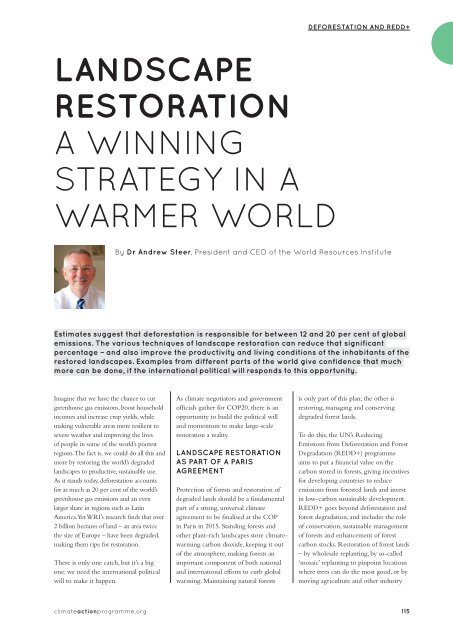Climate Action 2014-2015
Create successful ePaper yourself
Turn your PDF publications into a flip-book with our unique Google optimized e-Paper software.
DEFORESTATION AND REDD+<br />
LANDSCAPE<br />
RESTORATION<br />
A WINNING<br />
STRATEGY IN A<br />
WARMER WORLD<br />
By Dr Andrew Steer, President and CEO of the World Resources Institute<br />
Estimates suggest that deforestation is responsible for between 12 and 20 per cent of global<br />
emissions. The various techniques of landscape restoration can reduce that significant<br />
percentage – and also improve the productivity and living conditions of the inhabitants of the<br />
restored landscapes. Examples from different parts of the world give confidence that much<br />
more can be done, if the international political will responds to this opportunity.<br />
Imagine that we have the chance to cut<br />
greenhouse gas emissions, boost household<br />
incomes and increase crop yields, while<br />
making vulnerable areas more resilient to<br />
severe weather and improving the lives<br />
of people in some of the world’s poorest<br />
regions. The fact is, we could do all this and<br />
more by restoring the world’s degraded<br />
landscapes to productive, sustainable use.<br />
As it stands today, deforestation accounts<br />
for as much as 20 per cent of the world’s<br />
greenhouse gas emissions and an even<br />
larger share in regions such as Latin<br />
America. Yet WRI’s research finds that over<br />
2 billion hectares of land – an area twice<br />
the size of Europe – have been degraded,<br />
making them ripe for restoration.<br />
There is only one catch, but it’s a big<br />
one: we need the international political<br />
will to make it happen.<br />
As climate negotiators and government<br />
officials gather for COP20, there is an<br />
opportunity to build the political will<br />
and momentum to make large-scale<br />
restoration a reality.<br />
LANDSCAPE RESTORATION<br />
AS PART OF A PARIS<br />
AGREEMENT<br />
Protection of forests and restoration of<br />
degraded lands should be a fundamental<br />
part of a strong, universal climate<br />
agreement to be finalised at the COP<br />
in Paris in <strong>2015</strong>. Standing forests and<br />
other plant-rich landscapes store climatewarming<br />
carbon dioxide, keeping it out<br />
of the atmosphere, making forests an<br />
important component of both national<br />
and international efforts to curb global<br />
warming. Maintaining natural forests<br />
is only part of this plan; the other is<br />
restoring, managing and conserving<br />
degraded forest lands.<br />
To do this, the UN’s Reducing<br />
Emissions from Deforestation and Forest<br />
Degradation (REDD+) programme<br />
aims to put a financial value on the<br />
carbon stored in forests, giving incentives<br />
for developing countries to reduce<br />
emissions from forested lands and invest<br />
in low-carbon sustainable development.<br />
REDD+ goes beyond deforestation and<br />
forest degradation, and includes the role<br />
of conservation, sustainable management<br />
of forests and enhancement of forest<br />
carbon stocks. Restoration of forest lands<br />
– by wholesale replanting, by so-called<br />
‘mosaic’ replanting to pinpoint locations<br />
where trees can do the most good, or by<br />
moving agriculture and other industry<br />
climateactionprogramme.org 115












